Practice with the help of enVision Math Common Core Grade 2 Answer Key Topic 1 Fluently Add and Subtract Within 20 regularly and improve your accuracy in solving questions.
enVision Math Common Core 2nd Grade Answers Key Topic 1 Fluently Add and Subtract Within 20
Essential Question:
What are strategies for finding addition and subtraction facts?
Answer:
The Split and Jump strategies are used for finding Addition and Subtraction.
Explanation:
You can add or subtract the tens separately to the ones (or units).
For example, using the split strategy to add 46 + 23, you would split each number (decompose) into tens and ones: 46 + 23 = 40 + 6 + 20 + 3. rearrange the tens and ones: 40 + 20 + 6 + 3.
Using a Number Line or Number Chart. This is a very popular and visual way to help students work out subtraction problems.



enVision STEM Project: Material Math
Find Out Collect different types of paper. Talk about the uses of paper. Tell how strong each type of paper is. Tell how the paper feels. Tell if the paper can soak up water.
Journal: Make a Book Show what you find out in a book. In your book, also:
- Glue samples of paper and tell what you found.
- Choose a type of paper to make flash cards of addition and subtraction facts.
Answer:
Types of Paper:- Bond paper. This type of paper is stronger and more durable than the average sheet of paper.
- Gloss coated paper, it is typically used for flyers and brochures as it has a high shine.
- Matt coated paper, has a semi-gloss finish, produces high quality prints.
- Recycled paper, saves landfill space and reduces the amount of pollution in the air.
- Silk coated paper, used commonly for leaflets and flyers.
- Uncoated paper, used for books, letterheads, envelopes, note-pads and a number of other paper products.
USES OF PAPER :
It is a versatile material with many uses, including printing, packaging, decorating, writing, cleaning, filter paper, wallpaper, book endpaper, conservation paper, laminated worktops, toilet tissue, currency and security paper and a number of industrial and construction processes.Tell how the paper feels:
Answer may vary, but paper think poetically
u can write ur feelings,
scribble ur anger,
use me 2 absorb tears.
Don’t throw me after use but
when u feel cold burn me
to feel warm cause I Love you.
Tell if the paper can soak up water:
When paper soaked in water it readily absorbs water because it is made of cellulose, which water molecules like to cling to.- Make a List of the Journals Available. …
- Determine the Impact of the Journal. …
- Make Sure the Journal Scope and Policies match your Needs. …
- Check the Journal Requirements and Distribution. …
- Collect Information about the Journal’s Peer Review Process. …
- Glue samples of paper and tell what you found.
- Check the “Instructions for Authors” thoroughly.
Journal: Make a Book Show what you find out in a book. In your book.
-
- Make Your Own Flash Cards.
- Mix Pictures and Words.
- Use Mnemonic Devices to Create Mental Connections.
- Write Only One Question Per Card.
- Break Complex Concepts Into Multiple Questions.Observations of Glue samples of paper.
PVA Glue. The most versatile adhesive! PVA can be used on a wide range of surfaces: paper, card, fabric, wood, plaster and much more.
Preparation of flash cards:
Collect your materials together. This means that you should have your flash cards and textbook ready. Have a good pen, markers, highlighters, and whatever other writing implements you’d like to use.
Question 1.
Circle the symbol for equal
+
=
–
Answer:
![]()
Question 2.
Circle the symbol for minus.
–
+
=
Answer:
![]()
Question 3.
Circle the number that is the whole.
![]()
4 + 2 = 6
Answer:
![]()
Subtraction Stories
Question 4.
There are 7 birds on a fence. 2 fly away. How many birds are left?

_______ birds
Answer:
5 birds
Explanation:
Number of birds on fence = 5
Number of birds fly away = 2
Number of birds left = (7-2) = 5
Addition Stories
Question 5.
Write an equation to solve the problem.
Kate draws 4 big stars. Then she draws 2 small stars. How many stars does Kate draw in all?
______ + _____ = ______
Answer:
6 stars
Explanation:
__4___ + __2___ = ___6___
Number of big stars =4
Number of small stars =2
Total number of stars =6
Make 10
Question 6.
Write an equation that shows this way to make a 10.

Answer:
8+2=10
___8___ + ___2__ = __10____
Explanation:

By adding 2 to 8 we get 10.
Pick a Project
PROJECT 1A
What has 8 legs and is big and hairy?
Project: Make an Insect and Spider Poster
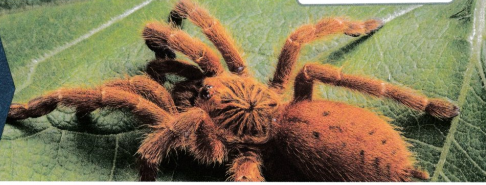
Answer:
Spider
YARN SPIDER CRAFT – MATERIAL
Materials Required:
1. YARN
2. STRYO FOAM BALL
3.PIPE CLEANERS
4. CHOP STICKS
5.HOT GLUE
6.GOOGLY EYES
Step 1. Wrap yarn around your styro foam ball. Once you’re done, secure the yarn with a bit of hot glue.
Step 2. Take your skinny long object like a chopstick and pierce two holes, one on each side of your yarn ball.
Step 3. Insert your pipe cleaners (cut into “legs”) you should have 4 legs per side.
Step 4. Glue on your googly eyes.

Project 1B
Project: Collect Water Data

| Water source | Water volume, in cubic miles | Water volume, in cubic kilometers | Percent of freshwater |
Percent of total water |
|---|---|---|---|---|
| Oceans, Seas, & Bays | 321,000,000 | 1,338,000,000 | — | 96.54 |
| Ice caps, Glaciers, & Permanent Snow | 5,773,000 | 24,064,000 | 68.7 | 1.74 |
| Groundwater | 5,614,000 | 23,400,000 | — | 1.69 |
| Fresh | 2,526,000 | 10,530,000 | 30.1 | 0.76 |
| Saline | 3,088,000 | 12,870,000 | — | 0.93 |
| Soil Moisture | 3,959 | 16,500 | 0.05 | 0.001 |
| Ground Ice & Permafrost | 71,970 | 300,000 | 0.86 | 0.022 |
| Lakes | 42,320 | 176,400 | — | 0.013 |
| Fresh | 21,830 | 91,000 | 0.26 | 0.007 |
| Saline | 20,490 | 85,400 | — | 0.006 |
| Atmosphere | 3,095 | 12,900 | 0.04 | 0.001 |
| Swamp Water | 2,752 | 11,470 | 0.03 | 0.0008 |
| Rivers | 509 | 2,120 | 0.006 | 0.0002 |
| Biological Water | 269 | 1,120 | 0.003 | 0.0001 |
PROJECT 1C
Have you seen this different kind of art?
Project: Create a Shape Collage

Answer:
BRINGING THE CONCEPT OF DIFFERENT COLORS AND SHAPES
PROJECT;
BRINGING THE CONCEPT OF DIFFERENT COLORS AND SHAPES
Materials required:
- Tissue paper (circles and squares)
- Old art or paper scraps
- Scissors
- Cardstock
- Clear glue or white glue
- Bows, Brushes
Process:
Depending on the time you have or the interest of your child, you can either set out some pre-cut shapes, or you can let you child cut their own shapes. Each child’s artwork is unique and reflects their personality. I love how one child overlapped her tissue and created new colors. Another child was keen to keep everything very orderly. And another barely used any pre-cut shapes and instead, used the scissors like Matisse and cut his own shapes.

- By making their own choices about color and composition, they are practicing their critical thinking skills.
They are exploring basic shapes and abstract shapes while creatively putting together an image.
This gives them an opportunity to associate shapes with real life objects. - When using the tissue paper, they are learning about transparency, and how colors can mix and overlap to make new colors.
3-ACT MATH PREVIEW
Math Modeling
Losing Marbles

Lesson 1.1 Addition Fact Strategies
Solve & Share
Use cubes. Show 2 + 5 and 5 + 2. Solve both problems. Explain how the problems are alike and how they are different.
I can … count on to add and add in any order.

Visual Learning Bridge

Convince Me! Does 5 + 2 = 2 + 5? How do you know?
Answer:
5+2=2+5=7
In additions there is no difference in addends, either from left to right the answer will be the same.
Guided Practice
Count on to find the sum. Then change the order of the addends.
Question 1.

Question 2.

Answer:
4+3=7
Explanation:
you can add numbers in any order and the sum is same, as shown below.

Independent Practice
Count on to find the sum. Then change the order of the addends. Use cubes if needed.
Question 3.
8 + 2 = ________
_______ + _______ = ________
Answer:
8+2=10
2+8=10
Explanation:

An equation uses an equal sign (=) to show that the value on the left is the same as the value on the right.
Question 4.
8 + 5 = ________
________ + ________ = ________
Answer:
8+5=13
5+8=13
Explanation:

An equation uses an equal sign (=) to show that the value on the left is the same as the value on the right.
Question 5.
9 + 3 = ________
________ + ________ = ________
Answer:
9+3=11
3+9=11
Explanation:

An equation uses an equal sign (=) to show that the value on the left is the same as the value on the right.
Question 6.
8 + 7 = ________
________ + ________ = ________
Answer:
8+7=15
7+8=15
Explanation:

An equation uses an equal sign (=) to show that the value on the left is the same as the value on the right.
Question 7.
7 + 10 = ________
________ + ________ = ________
Answer:
7+10=17
10+7=17
Explanation:

An equation uses an equal sign (=) to show that the value on the left is the same as the value on the right.
Question 8.
7 + 9 = ________
________ + ________ = ________
Answer:
7+9=16
9+7=16
Explanation:

An equation uses an equal sign (=) to show that the value on the left is the same as the value on the right.
Question 9.

Answer:
7+2=9
Explanation:
you can add numbers in any order and the sum is same, as shown below.

Question 10.

Answer:
6+2=8
Explanation:
you can add numbers in any order and the sum is same, as shown below.

Question 11.

Answer:
5+6=11
Explanation:
you can add numbers in any order and the sum is same, as shown below.

Question 12.
Algebra Write the missing numbers.
6 + ____ = 4 + 6
8 + 2 = ____ + 8
6 + ____ = 5 + 6
____ + 7 = 7 + 4
9 + 3 = 3 + ____
____ + 8 = 8 + 4
Answer:

Explanation:
you can add numbers in any order and the sum is same, in the above pattern.
Problem Solving
Solve the problems below.

Question 13.
Model Joy has 8 bean plants and 6 corn plants in her garden. How many plants does she have in all? Draw a picture to explain your thinking. Then write facts for this story with the addends in a different order.
____ + ____ = ____
____ + ____ = ____
Answer:
8+6=14
Explanation:

Question 14.
Higher Order Thinking Find the objects in Box I and Box 2 that are the same. Write an equation to show how many of each object there are. Then change the order of the addends.

Answer:

Question 15.
Assessment Practice which shows how to count on to find 7 + 5?
A. 7… 8, 9, 10, 11, 12
B. 1, 2, 3, 4, 5
C. 7 – 5
D. 7…8, 9, 10, 11
Answer:
Option A
Explanation:
Keep 7 in your mind and five fingers open, then count 8,9,10,11,12

Lesson 1.2 Doubles and Near Doubles
Solve & Share
Use counters. Show 6 + 6 = 12. Then show and explain how knowing that fact can help you find 6 + 7.
I can … use doubles and near doubles to add quickly and accurately.

Visual Learning Bridge

Convince Me! How could you use the doubles fact 7 + 7 to find 7 + 9?
Answer:
You can use a double fact in additions to add the addends.
Explanation:
7+8 is 1 more than 7+7
7+8=15
7+9 is 2 more than7+7
7+9=15
So these are near double facts.
Guided Practice
Complete the doubles facts. Use the doubles facts to solve the near doubles. Use cubes if needed.
Question 1.
2 + 2 = _______
2 + 3 = _______
Answer:
2+2=4
2+3=5
Explanation:
So these are near double facts.

Question 2.
_______ = 4 + 4
_______ = 4 + 5
Answer:
4+4=8
4+5=9
Explanation:
So these are near double facts.

Question 3.

Answer:

Explanation:
A near double is a math fact that is close to a doubles fact.
For example, 3+4 is considered a near double because it is close to the doubles fact 3+3.
Near doubles could be doubles plus one facts, doubles plus two facts, or doubles minus one facts.
So 6 and 7 are the nearest double facts.
Question 4.

Answer:

Explanation:
A near double is a math fact that is close to a doubles fact.
For example, 5+7 is considered a near double because it is close to the doubles fact 5+5.
Near doubles could be doubles plus one facts, doubles plus two facts, or doubles minus one facts.
So 10 and 12 are the nearest double facts.
Independent Practice
Complete the doubles facts. Use the doubles facts to solve the near doubles. Use cubes if needed.
Question 5.
6 + 6 = _______
6 + 7 = _______
Answer:
6+6=12
6+7=13
Explanation:

Question 6.
5 + 5 = _______
5 + 6 = _______
Answer:
5+5=10
5+6=11
Explanation:

Question 7.
8 + 8 = _______
8 + 10 = _______
Answer:
8 + 8 = 16
8 + 10 = 18
Explanation:

Question 8.
_______ = 1 + 1
_______ = 1 + 3
Answer:
2 = 1 + 1
4 = 1 + 3
Explanation:

Question 9.

Answer:

Explanation:
A near double is a math fact that is close to a doubles fact.
For example, 2+2 is considered a near double because it is close to the doubles fact 2+3.
Near doubles could be doubles plus one facts, doubles plus two facts, or doubles minus one facts.
So 4 and 5 are the nearest double facts.
Question 10.

Answer:

Explanation:
A near double is a math fact that is close to a doubles fact.
For example, 4+4 is considered a near double because it is close to the doubles fact 4+5.
Near doubles could be doubles plus one facts, doubles plus two facts, or doubles minus one facts.
So 8 and 9 are the nearest double facts.
Question 11.

Answer:

Explanation:
A near double is a math fact that is close to a doubles fact.
For example, 8+8 is considered a near double because it is close to the doubles fact 8+9.
Near doubles could be doubles plus one facts, doubles plus two facts, or doubles minus one facts.
So 16 and 17 are the nearest double facts.
Question 12.

Answer:

Explanation:
A near double is a math fact that is close to a doubles fact.
For example, 3+73is considered a near double because it is close to the doubles fact 3+5.
Near doubles could be doubles plus one facts, doubles plus two facts, or doubles minus one facts.
So 6 and 8 are the nearest double facts.
Question 13.
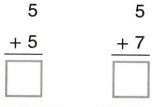
Answer:

Explanation:
A near double is a math fact that is close to a doubles fact.
For example, 5+5 is considered a near double because it is close to the doubles fact 5+7.
Near doubles could be doubles plus one facts, doubles plus two facts, or doubles minus one facts.
So 10 and 12 are the nearest double facts.
Question 14.

Answer:

Explanation:
A near double is a math fact that is close to a doubles fact.
For example, 7+7 is considered a near double because it is close to the doubles fact 7+9.
Near doubles could be doubles plus one facts, doubles plus two facts, or doubles minus one facts.
So 14 and 16 are the nearest double facts.
Question 15.
Algebra Complete. Then explain how you solved the problem.

Answer:

Explanation:
A near double is a math fact that is close to a doubles fact.
9+9is considered a near double because it is close to the doubles fact 9+10.
Near doubles could be doubles plus one facts, doubles plus two facts, or doubles minus one fact
Problem Solving
Solve the problems below.
Question 16.
Model John drew 4 houses. Then he drew 5 more houses. How many houses did John draw in all?
Draw a picture and write an equation to explain your thinking.
![]() _______ houses
_______ houses
Answer:
9 houses
Explanation:
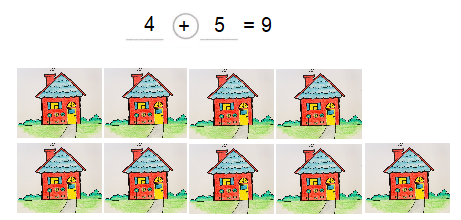
Question 17.
Higher Order Thinking Choose a doubles fact. Use that doubles fact to draw a picture that shows a near doubles story. Write the near doubles fact.
Answer:
Near doubles could be doubles plus one facts, doubles plus two facts, or doubles minus one facts.
Let’s take a look at the doubles fact 5+5. 5+6 would be the double plus one (5+5 plus one more).
5+7 would be the double plus two (5+5 plus two more).23-Jul-2020
Question 18.
Assessment Practice Kate wants to find 6 + 7.

Which doubles fact will help her the most?
A. 4 + 4 = 8
B. 6 + 6 = 12
C. 8 + 8 = 16
D. 9 + 9 = 18
Answer:
Option B
6+6=12
6+7=13
6+7 is one more then 6+6
Lesson 1.3 Make a 10 to Add
Solve & Share
How can thinking about 10 help you find 9 + 3? Use the ten-frames and counters to show how.
I can … make a 10 to help me add quickly and accurately.

Visual Learning Bridge

Convince Me! Why do you move 2 counters to add 8 + 5?
Answer:
Addition can be thought of as combining two quantities and finding the total to add two plus eight combined five yellow counters and eight red counters. There are 13 counters in total.
Explanation:
8+5=13
10+3=13
Guided Practice
Make a 10 to add. Use counters and ten-frames.
Question 1.

Answer:
7+4=11
Explanation:

Independent Practice
Make a 10 to add. Use counters and ten-frames.
Question 2.

Answer:
8+4=12
Explanation:

Question 3.

Answer:
3+9=12
Explanation:

Question 4.

Answer:
6+7=13
Explanation:

Question 5.

Answer:
5+8=13

Question 6.

Answer:
7+5=12
Explanation:

Question 7.
5 + 9 = _______

Answer:
5+9=14
Explanation:

Question 8.
3 + 8 = ________

Answer:
3+8=11
Explanation:

Question 9.
4 + 9 = ______

Answer:
4+9=13
Explanation:

Question 10.
7 + 9 = _______

Answer:
7+9=16
Explanation:

Algebra Which number is missing?
Question 11.
8 + 5 = ![]() + 3
+ 3
Answer:
10 is missing
Explanation:
8+5=13
10+3=13
Question 12.
6 + 9 = 10 + ![]()
Answer:
5 is missing
Explanation:
6+9=15=10+5
Question 13.
8 + 9 = 10 + ![]()
Answer:
7 is missing
Explanation:
8+9=17=10+7
Question 14.
Higher Order Thinking Can you make a 10 to help you add 7 + 4 + 5? Explain.
Answer: 16

Explanation:
The make–ten strategy is great for addition! It helps students understand place value and the relationships between numbers.
Ten-frames help students develop a good “mind picture” for the make–ten strategy because our place-value system is based on making groups of ten.
Problem Solving
Solve the problems below. Show your work.
Question 15.
Tan’s team scored 16 points in a game. During the first half, they scored 9 points. How many points did the team score in the second half of the game?
_________ points
Answer:
Tan’s team score 7 points in second half.
Explanation:
Total points scored by Tan’s team = 16
In first half they scored = 9 points
In second half they scored (16-9)=7 points.
Question 16.
Make Sense The school has a clothing drive for charity. Ana’s class donates 8 coats. Nico’s class donates 5 hats. Adam’s class donates 8 coats. How many coats were donated in all?
_________ coats
Answer:
16 coats were donated in all.
Explanation:
No of coats donated by Ana’s class = 8
No of hats donated by Adam’s class = 5
No of coats donated by Nico’s class = 8
Total coats donated in all (8+8) = 16
Question 17.
Higher Order Thinking Draw a picture to show how you can make a 10 to help you add 3 + 5 + 9. Explain your picture to a friend.
Answer:
Question 18.
Assessment Practice Use the ten-frames. Show how to find 5 + 7 by making a 10. Then fill in the gray boxes.

Answer: 12
Explanation:

Lesson 1.4 Addition Fact Patterns
Solve & Share
Look at the sums on an addition facts table for addends 0 to 5. Describe one of the patterns that you see. Use words, colors, or addition facts to describe the patterns.
I can … use the patterns on an addition facts table to help me remember the addition facts.

Visual Learning Bridge

Convince Me! How can patterns on an addition facts table help you remember the addition facts? Explain.
Answer:
The addition facts are all of the sums from 0+1 or 1+0 up to 10+10.
Explanation:
It’s essential that children master in sums, because they’re the foundation for the rest of elementary arithmetic.
Here’s the full addition facts chart is above shown picture.
Guided Practice
Use fact patterns to complete each equation.
Question 1.


Question 2.
10+ ______ = 14
______ + 5 = 14
8 + 6 = ______
7 + ______ = 14
______ + 8 = 14
5 + ______ = 14
______ + 10 = 14
Answer:

Explanation:

By adding 4 to 10,9 to5,8 to 6, 7 to 7, 6 to 8, 5 to 9, 4 to 10 the answer will be 10 only.
So it tells the facts about number patterns.
Question 3.
9 + ______ = 9
______ + 1 = 9
7 + 2 = ______
6 + ______ = 9
______ + 4 = 9
5 + ______ = 9
______ + 3 = 9
______ + 2 = 9
8 + 1 = ______
______ + 0 = 9
Answer:
9+0=9
8+1=9
7+2=9
6+3=9
5+4=9
4+5=9
3+6=9
2+7=9
1+8=9
9+0=9
Explanation:

Independent Practice
Use fact patterns to complete each equation.
Question 4.
10 + ______ = 12
______ + 3 = 12
8 + 4 = ______
7 + ______ = 12
6 + 6 = ______
______ + 7 = 12
4+ ______ = 12
______ + 9 = 12
Answer:
10+2=12
9+3=12
8+4=12
7+5=12
6+6=12
5+7=12
4+8=12
3+9=12
Explanation:

Question 5.
7 + ______ = 7
______ + 1 = 7
5 + 2 = ______
______ + 3 = 7
______ + 4 = 7
______ + 5 = 7
______ + 6 = 7
0 + ______ = 7
Answer:
7+0=7
6+1=7
5+2=7
4+3=7
3+4=7
2+5=7
1+6=7
0+7=7
Explanation:

Question 6.
10+ ___ = 15
______ + 5 = 15
9 + 6 = ______
9 + ______ = 15
7 + ______ = 15
______ + 8 = 15
Answer:
10+ _5__ = 15
_10__ + 5 = 15
9 + 6 = _15__
9 + __6__ = 15
7 + __8__ = 15
_7_ + 8 = 15
Explanation:

Question 7.
Number Sense Find the 8 in the top row of the addition facts table. Complete all of the equations using the 8-column on the table. What pattern do you see?
8 + ______ = 8
8 + ______ = 9
8 + ______ = 10
8 + 3 = ______
8 + ______ = 12
8 + =
8 + 6 = ______
8 + ______ = 15
8 + 8 = ______
8 + 10 = ______
Answer:

Explanation:

Problem Solving
Solve the problems below.
Question 8.
Reasoning Lucy is sorting items by their texture. She finds 6 items that are bumpy. Lucy finds 5 items that are smooth. How many items does Lucy find in all?
_________ items
Answer:
Lucy find 12 items in all.
Explanation:
Number of items that are bumpy = 6
Number of items that are smooth =5
Total items that Lucy had = 12
Question 9.
Vocabulary Look at the equation below. Circle the addends. Draw a square around the sum.
9 + 5 = 14
Answer:

Explanation:
In the above equation 9 and 5 are addends.
14 is the sum.
Question 10.
Higher Order Thinking Write 8 addition facts that have a sum of 12. How can the addition patterns help you? Explain.
Answer:
8+4=12
4+8=12
Explanation:
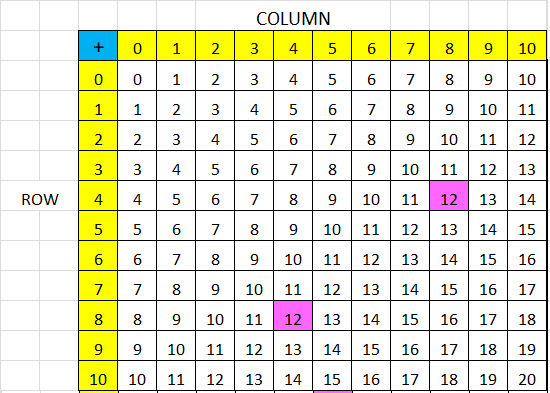
Question 11.
Assessment Practice which have a sum of 17? Choose all that apply.
Think about fact patterns.
☐ 10 + 7 = ?
☐ 7 + 6 = ?
☐ 9 + 8= ?
☐ 8 + 8 = ?
Answer:
10+7=17
9+8=17
Explanation:

Lesson 1.5 Count On and Count Back to Subtract
Solve & Share
How can counting help you find 12 – 4? Use the number line to show your work.
I can … count on and count back on a number line to subtract.
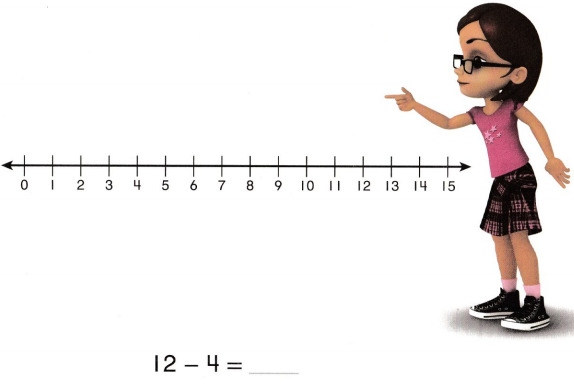
Answer:
12-4=8
Explanation:

Start with greater number and count back 8 moves to find the difference.
Visual Learning Bridge
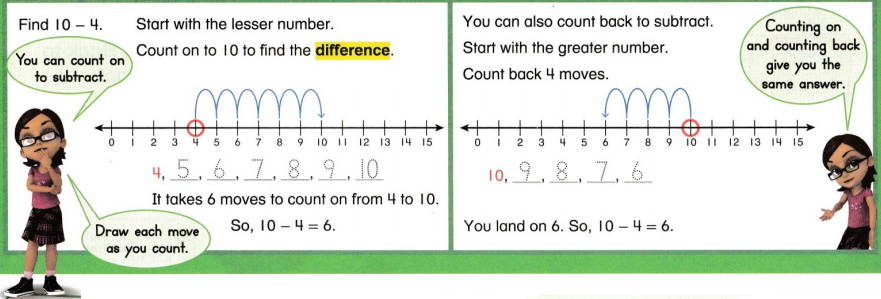
Convince Me! How can you count back on a number line to find 9 – 5?
Answer:
9-5=4
Start with greater number and count back 5 moves to find the difference.
Explanation:

Subtraction of numbers using number line will help us to learn how a number line can be used for subtracting one number from the another number. Subtraction of numbers can be well understood with the help of the number line.
Guided Practice
Count on or count back to subtract. i.e Show your work on the number line.
Question 1.

Question 2.
14 – 7 = ![]()

Answer:
14-7=7
Explanation:
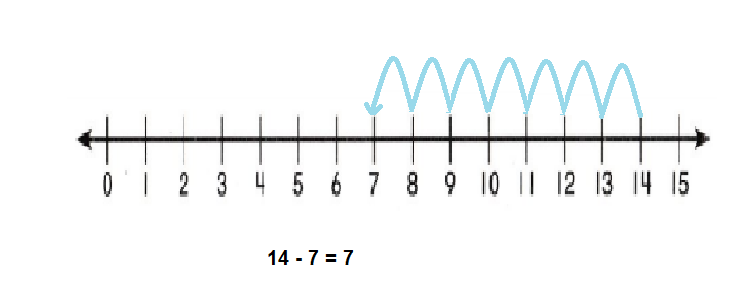
Independent Practice
Count on or count back to subtract. Show your work on the number line.
Question 3.
14 – 8 = ![]()

Answer:
14-8=6
Explanation:

Question 4.
12 – 7 = ![]()

Answer:
12-7=5
Explanation:

Question 5.
9 – 7 = ![]()

Answer:
9-7=2
Explanation:

Question 6.
15 – 6 = ![]()

Answer:
15-6=9
Explanation:

Question 7.
Higher Order Thinking How can you count on to find 13 – 4? Explain.
Answer:
13-4=9
Explanation:

Start with lesser number and count on to 13 to find the difference.
Problem Solving
Solve the problems below.
Question 8.
Callie had 18 seeds. She planted 10 of the seeds. How many seeds does Callie have now?
________ seeds
Answer:
After planting10 seeds Callie had 8 seeds.

Explanation:
Number of seeds = 18
Number seeds planted = 10
Total number of seeds left = 18-10=8
Question 9.
Make Sense Peter has 16 grapes. He eats some of the grapes. Peter has 10 grapes left. How many grapes did Peter eat?
________ grapes
Answer:
Peter ate 6 grapes.
Explanation:
Total number of grapes = 16
Number of grapes left = 10
Some of the grapes eaten by Peter = 16-10=6

Question 10.
Higher Order Thinking Choose 2 numbers. Use the numbers to write or draw a subtraction story. Write the equation you used to solve your story.
______ – _______ = ________
Answer:
9 – 7 = 2
Explanation:
Start with greater number and count back 2 moves to find the difference.
Question 11.
Assessment Practice Jake wants to find 6 – 3.
Use the numbers on the cards. Write them in the boxes to show how to use a number line to count on to solve.
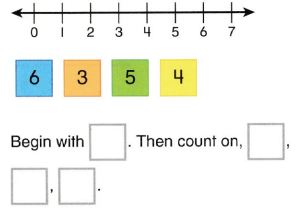
6 – 3 = _______
Answer:
6-3=3
Explanation:
Begin with greater number 6 and count on to lesser number 3, then difference is 3.

Lesson 1.6 Think Addition to Subtract
Solve & Share
How can you use an addition fact to find 14 – 6? Use counters to help show how.
I can … use addition to help me subtract quickly and accurately.
_____ + _______ = ________
So, 14 – 6 = _______
Answer:
6 + 8 = 14
14 – 6 =8
Explanation:
The basic facts of addition are those equations in which two single-digit numbers are combined by addition to give a sum. The missing number is the same in both equation.
Addition Fact 6+8=14
Subtraction Fact 14- 6 =8
Question 3.
Visual Learning Bridge

Convince Me! How do you know which addition fact to use to complete the subtraction fact?
Answer:
In the case of addition and subtraction, you use three numbers and get four facts.
- For example, you can form a fact family using the three numbers 3, 10, and 13: 10 + 3 = 13, 3 + 10 = 13, 13 − 10 = 3, and 13 − 3 = 10.
- Addition facts − Here the sum of two of the three given numbers is the remaining third number.
Guided Practice
Think addition to help you subtract.
Question 1.

Question 2.
9 – 3 = ?
3 + _______= 9
So, 9 – 3 = _______
Answer: 6
9 – 3 = 6
3 + 6= 9
So, 9 – 3 = 6
Explanation:
The basic facts of addition are those equations in which two single-digit numbers are combined by addition to give a sum. The missing number is the same in both equation.
Addition Fact 3+6=9
Subtraction Fact 9 – 3 = 6
So,9-3=6
Question 3.
14 – 5 =
5 + _____=4
So, 14 – 5 = _____
Answer: 9
14 – 5 = 9
5 + 9 = 14
So, 14 – 5 = 9
Explanation:
The basic facts of addition are those equations in which two single-digit numbers are combined by addition to give a sum. The missing number is the same in both equation.
Addition Fact 14-6=9
Subtraction Fact 5+9=14
So 14-5=9
Question 4.
12 – 4 = ?
4 + _______ = 12
So, 12 – 4 = _______
Answer: 8
12 – 4 = 8
4 + 8 = 12
So, 12 – 4 = 8
Explanation:
The basic facts of addition are those equations in which two single-digit numbers are combined by addition to give a sum. The missing number is the same in both equation.
Addition Fact 12-4=8
Subtraction Fact 4+8=12
So,12-4=8
Independent Practice
Subtract. Complete the addition fact that can help you.
Question 5.
8 – 1 = _______
1 + _______ = 8
Answer: 7
8 – 1 = 7
1 + 7 = 8
Explanation:
The basic facts of addition are those equations in which two single-digit numbers are combined by addition to give a sum.
Hence they range from 0+0=0 to 9+9=18.
For each basic addition fact there is a related basic subtraction fact.
Question 6.
10 – 2 = _______
2 + _______ = 10
Answer: 8
10 – 2 = 8
2 + 8= 10
Explanation:
Addition and subtraction are inverse operations because one operation can “undo” the other operation.
Adding 2 and 8 to get 10 is the opposite of 10 minus 2, leaving 8.
Question 7.
15 – 6 = _______
6 + _______ = 15
Answer: 9
15 – 6 = 9
6 + 9= 15
Explanation:
Addition and subtraction are inverse operations because one operation can “undo” the other operation.
Adding 6 and 9 to get 15 is the opposite of 15 minus 6, leaving 9.
Question 8.
17 – 7 = _______
7 + _______ = 17
Answer: 10
17 – 7 = 10
7 + 10 = 17
Explanation:
Addition and subtraction are inverse operations because one operation can “undo” the other operation.
Adding 7and 10 to get 17 is the opposite of 17 minus 7, leaving 17.
Question 9.
14 – 8 = _______
8 + _______ = 14
Answer: 6
14 – 8 = 6
8 + 6 = 14
Explanation:
Addition and subtraction are inverse operations because one operation can “undo” the other operation.
Adding 8 and 6 to get 14 is the opposite of 14 minus 8, leaving 6.
Question 10.
9 – 5 = _______
5 + _______ = 9
Answer: 4
9 – 5 = 4
5 + 4 = 9
Explanation:
Addition and subtraction are inverse operations because one operation can “undo” the other operation.
Adding 5 and 4 to get 9 is the opposite of 9 minus 5, leaving 4.
Question 11.

Answer: 10

Explanation:
Addition and subtraction are inverse operations because one operation can “undo” the other operation.
Adding 8 and 10 to get 18 is the opposite of 18 minus 8, leaving 10
Question 12.

Answer: 7
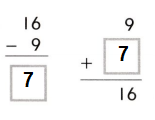
Explanation:
Addition and subtraction are inverse operations because one operation can “undo” the other operation.
Adding 9 and 7 to get 16 is the opposite of 16 minus 9, leaving 7
Question 13.

Answer: 10

Explanation:
Addition and subtraction are inverse operations because one operation can “undo” the other operation.
Adding 10 and 9 to get 19 is the opposite of 19 minus 9, leaving 10
Higher Order Thinking Write a related addition fact to complete the subtraction fact.
Question 14.
11 – _______ = 5
______ + ______ = _______
Answer:
11 – 6 =5
5 + 6 = 11
Explanation:
Addition and subtraction are inverse operations because one operation can “undo” the other operation.
Adding 5 and 6 to get 11 is the opposite of 11 minus 6, leaving 5
Question 15.
7 – _______ = 2
_______ + _______ = _______
Answer:
7 – 5 =2
2 + 5 = 7
Explanation:
Addition and subtraction are inverse operations because one operation can “undo” the other operation.
Adding 2 and 5 to get 7 is the opposite of 7 minus 5, leaving 2
Question 16.
12 – _______ = 8
_______ + _______ = _______
Answer:
12 – 4 =8
8 + 4 = 12
Explanation:
Addition and subtraction are inverse operations because one operation can “undo” the other operation.
Adding 8 and 4 to get 12 is the opposite of 12 minus 4, leaving 8
Problem Solving
Solve the problems below. Write an equation.
Question 17.
Reasoning Kate had 6 pens. She got 5 more pens from John. How many pens does Kate have in all?
![]()
______ pens
Answer:11 pens

Explanation:
Number of pens Kate had 6
John gave 5 more pens
Total pens Kate has 11
Question 18.
Reasoning John had 11 pens. He gave 5 pens to Kate. How many pens does John have now?
![]()
_______ pens
Answer: 6 pens

Explanation:
John had 11 pens.
John gave 5 pens to Kate.
Total pens does John have now is 6
Question 19.
Higher Order Thinking Write a subtraction story using the numbers 18 and 10. Then write an addition fact that can help you solve the problem in your story.
Answer:
Peter has 18 chocolates.
He eats 10 chocolates.
Now Peter has 18 chocolates in total.
18 – 10 = 8
10 + 8 = 18
Question 20.
Assessment Practice Pam has 16 cherries. She eats 7 cherries. Which addition fact can help you find how many cherries Pam has left?

A. 7 + 4 = 11
B. 7 + 9 = 16
C. 7 + 6 = 13
D. 9 + 9 = 18
Answer:
Option B
Explanation:
16-7=11
11+7=16
Lesson 1.7 Make a 10 to Subtract
Solve & Share
14 ladybugs are on a leaf. 6 ladybugs fly away. How can thinking about 10 help you find how many ladybugs are left? Explain.
I can … make a 10 to help me subtract quickly and accurately.

![]()


Visual Learning Bridge

Convince Me! Do you prefer to add first to get to 10 or subtract first to get to 10? Explain.
Answer:
Yes, i prefer addition first.
Explanation:
Add first to get 10 as shown in the above,
Then add 3 more to make 13.
Guided Practice
Make a 10 to subtract. Use counters and your workmat.
Question 1.
First add to get to 10.

Answer:7

Question 2.
First subtract to get to 10.

Answer: 9
Explanation:

Independent Practice
Make a 10 to subtract. Use counters and your workmat.
Think of the ways you know to make 10.
Question 3.
![]()
Answer: 7
Explanation:

Question 4.
![]()
Answer: 6
Explanation:

Question 5.
![]()
Answer: 5
Explanation:

Question 6.
![]()
Answer: 8
Explanation:

Question 7.
![]()
Answer: 9
Explanation:

Question 8.
![]()
Answer: 9
Explanation:

Question 9.
![]()
Answer: 8
Explanation:

Question 10.
![]()
Answer: 9
Explanation:

Question 11.
![]()
Answer: 6
Explanation:

Question 12.
![]()
Answer: 7
Explanation:

Question 13.
![]()
Answer: 4
Explanation:

Question 14.

Answer: 7
Explanation:

Question 15.
Higher Order Thinking Carol subtracts 6 from 15. First, she adds to get to 10. Then she adds again to find her answer. Her answer is 10. Is Carol correct? Explain.
Answer: 9
No, her answer is wrong
Explanation :
15-6=9
she added 1 + 9 to get 10
She added again 5 +10 = 15
Problem Solving
Solve each problem. Which tool would you use?
Question 16.
Use Tools Chen had 12 animal stickers. He gave 5 of the stickers away. How many animal stickers does Chen have now?
________ animal stickers
Answer: 7 stickers
Explanation:

Question 17.
Use Tools Angie bought 13 strawberries. She ate 8 of the strawberries. How many strawberries does Angie have now?
________ strawberries
Answer: 5
Explanation:

Question 18.
Higher Order Thinking Show how you can make a 10 to find 17 – 9. Then explain your work.
Answer: 8
Explanation:

Question 19.
Assessment Practice Use the ten-frames. Show how to make a 10 to find 15 – 9. Start by subtracting to get to 10. Then complete the equations.

15 – _____ = 10
10 – _____ = _____
So, 15 – 9 =_____;
Answer:
15 – 5 = 10
10 – 4 = 6
15 – 9 =6
Explanation:

Lesson 1.8 Practice Addition and Subtraction Facts
Solve & Share
Write four related facts that use both the numbers 7 and 9 as quickly as you can. Hold up your hand when you are done. Then, tell how you found each fact.
I can … add and subtract quickly and accurately using mental math strategies.

9 + 7 = 16 16 – 7 = 9
7 + 9 = 16 16 – 9 = 7
Visual Learning Bridge

Convince Me! How can thinking about 10 help you find 14 – 8?
Answer : 6
Explanation:

Guided Practice
Add or subtract. Use any strategy.
Question 1.
![]()
Answer : 5
Explanation:
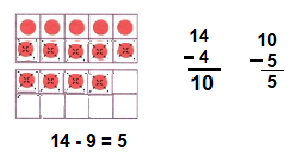
Question 2.

Answer: 8
Explanation:

Question 3.
![]()
Answer: 12
Explanation:

Question 4.
![]()
Answer: 5
Explanation:

Question 5.
![]()
Answer: 6
Explanation:

Question 6.
![]()
Answer: 18
Explanation:

Question 7.
![]()
Answer: 8
Explanation:

Question 8.

Answer: 20
Explanation:

Question 9.

Answer: 7
Explanation:

Question 10.
![]()
Answer: 10
Explanation:

Question 11.
![]()
Answer: 8
Explanation:

Question 12.
![]()
Answer: 8
Explanation:

Independent Practice
Add or subtract. Use any strategy.
Question 13.
14 – 7 = ________
Answer:
14-7=7
Explanation:
By subtracting smaller number 7 from greater number 14 we get the difference 7.
Question 14.
3 + 0 = ________
Answer:
3+0=3
Explanation:
By adding 3 to 0 we get the sum 3.
Question 15.
8 + 7 = ________
Answer:
8+7=15
Explanation:
By adding 8 to 7 we get the sum 15.
Question 16.
13 – 6 = ________
Answer:
13-6=7
Explanation:
By subtracting smaller number 6 from greater number 13 we get the difference 7.
Question 17.
10 + 9 = ________
Answer:
10+9=19
Explanation:
By adding 10 to 9 we get the sum 19.
Question 18.
17 – 8 = ________
Answer:
17-8=9
Explanation:
By subtracting smaller number 8 from greater number 17 we get the difference 9.
Question 19.
18 – 9 = ________
Answer:
18-9=9
Explanation:
By subtracting smaller number 9 from greater number 18 we get the difference 9.
Question 20.
9 – 1 = ________
Answer:
9-1=8
Explanation:
By subtracting smaller number 1 from greater number 9 we get the difference 8.
Question 21.
7 + 4 = ________
Answer:
7+4=11
Explanation:
By adding 7 to 4 we get the sum 11.
Question 22.
6 + 6 = ________
Answer:
6+6=12
Explanation:
By adding 6 to 6 we get the sum 12.
Question 23.
16 – 9 = ________
Answer:
16-9=7
Explanation:
By subtracting smaller number 9 from greater number 16 we get the difference 7.
Question 24.
20 – 10 = ________
Answer:
20-10=10
Explanation:
By subtracting smaller number 10 from greater number 20 we get the difference 10.
Question 25.
16 – 7 = ________
Answer:
16-7=9
Explanation:
By subtracting smaller number 7 from greater number 16 we get the difference 9.
Question 26.
15 – 8 = ________
Answer:
15-8=7
Explanation:
By subtracting smaller number 8 from greater number 15 we get the difference 7.
Question 27.
7 + 3 = ________
Answer:
7+3=10
Explanation:
By adding 3 to 7 we get the sum 10.
Question 28.
2 + 7 = ________
Answer:
2+7=9
Explanation:
By adding 2 to 7 we get the sum 9.
Question 29.
9 + 6 = ________
Answer:
9+6=15
Explanation:
By adding 9 to 6 we get the sum 15.
Question 30.
10 – 2 = ________
Answer:
10-2=8
Explanation:
By subtracting smaller number 2 from greater number 10 we get the difference 8.
Higher Order Thinking Write the missing number.
Question 31.
6 + ☐ = 14 – 5
Answer: 3
6 + 3 = 14 – 5
Question 32.
12 – 4 = ☐ + 2
Answer: 6
12 – 4 = 6 + 2
Question 33.
14 – ☐ = 5 + 4
Answer: 5
14 – 5 = 5 + 4
Problem Solving
Solve the problems below.
Question 34.
en Vision® STEM Danielle had 17 pieces of paper. She changed 8 of the pieces by cutting them. How many pieces were not changed? Write an equation to solve.
![]()
__________ pieces of paper
Answer: 9
![]()
Explanation:
Danielle had 17 piece.
She used 8 pieces for cutting.
After cutting no. of pieces left with her 9.
Question 35.
Model Diego saw 5 frogs on a rock. He also saw 7 frogs in the grass. How many frogs did Diego see in all? Write an equation to solve.
![]()
_______ frogs
Answer: 12
![]()
Explanation:
Number of frogs Diego saw on rock = 5
Number of frogs Diego saw in the grass = 7
Total number of frogs he saw together = 12
Question 36.
Higher Order Thinking Glen counts on to solve 9 + ☐ = 14. Explain how he can do this. What is the missing addend?
Answer: 5

Explanation:
Addition and subtraction are inverse operations because one operation can “undo” the other operation
Question 37.
Assessment Practice Choose a strategy to find 11 – 8. Explain how you used the strategy to find the difference.
Which strategy will you use to solve this problem?
Answer: 3
Explanation:

By using number line strategy, counting from bigger number to smaller number with back moves
Lesson 1.9 Solve Addition and Subtraction Word Problems
Solve & Share
Diego has 6 apples. Leslie has 9 apples. How many more apples does Leslie have than Diego? Will you add or subtract to solve this problem? Explain.
Answer:3
Leslie has 3 more apples.
Explanation:
By subtracting smaller number 6 from greater number 9 we get the difference 3.
I can … use addition and subtraction to solve word problems.

Visual Learning Bridge

Convince Me! Why can you use addition OR subtraction to solve the problem above?
Answer:
Addition and subtraction are inverse operations because one operation can “undo” the other operation.
Guided Practice
Write an equation to solve each problem. Use any strategy.
Question 1.
Sam has 5 red tomatoes and 3 green tomatoes. How many tomatoes does he have in all?
![]()
Answer: 8

Explanation:
By adding 3 to 5 we get the sum 8.
Question 2.
There are 16 party hats in a box. There are 10 party hats in a bag. How many fewer hats are in the bag than in the box?
![]()
______ fewer hats
Answer: 6
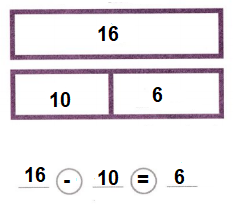
Explanation:
By subtracting smaller number 10 from bigger number 16, we get the difference 6.
Independent Practice
Write an equation to solve each problem. Use any strategy.
Question 3.
Cho has 3 more toy horses than Hakeem. Cho has 9 toy horses. How many toy horses does Hakeem have?
![]()
________ toy horses
Answer: 6

Explanation:
By subtracting smaller number 9 from bigger number 15, we get the difference 6.
Question 4.
There are 12 peaches in a bowl. The children eat some of them. Now there are 8 peaches. How many peaches did the children eat?
![]()
________ peaches were eaten.
Answer: 4

Explanation:
By subtracting smaller number 8 from bigger number 12, we get the difference 4.
Question 5.
Juan reads 5 books. Susan reads some books. They read 11 books in all. How many books did Susan read?
![]()
__________ books
Answer: 6

Explanation:
By subtracting smaller number 5 from bigger number 11, we get the difference 6.
Question 6.
Jack has 13 brushes. Igor has 6 brushes. How many fewer brushes does Igor have than Jack?
![]()
_______ fewer brushes
Answer: 7

Explanation:
By subtracting smaller number 6 from bigger number 13, we get the difference 7.
Question 7.
Number Sense Jen had 3 animal stickers in her collection. Her friend gave her 5 more stickers. Jen bought 7 more stickers. How many stickers does Jen have now? Show your work.
Answer:
15 stickers.
Explanation:
Jen had 3 animal stickers first and her friend gave 5 more, now she has total 8 stickers. Next
3 + 5 = 8
Jen bought 7 more and added to 8 animal stickers, now total 15 animal stickers.
8 +7 = 15

Problem Solving
Solve the problems below.
Question 8.
Higher Order Thinking Sandy has 8 markers. Alex has 6 fewer markers than Sandy. Jill has 2 markers. How many markers do they have in all? Show your work. Then explain how you found the answer.
Answer:
12 markers.
Explanation:
Sandy has 8 markers
Alex has 8 – 6 = 2 markers (subtract 6 from Sandy 8 markers as fewer or less)
Jill has 2 markers
Total 8 + 2 + 2 = 12

Use counters to solve.
Question 9.
Make Sense Annika saves 13 dimes. She put some of the dimes in a box and the rest in a jar. Write an equation to show one way she could have sorted the dimes.
![]()
________ dimes in a jar
________ dimes in a box
Answer:
Addition can be thought of as combining two quantities and finding the total to add 6 dimes plus 7 dimes combined counters. There are 13 counters in total.
Explanation:
6 + 7 = 13
7 + 6 =13
6 dimes in a jar
7 dimes in a box

Question 10.
Assessment Practice Maria had 5 rings. She bought some more rings. Now she has 12 rings. Choose Yes or No to show if the equation can be used to find how many more rings Maria bought.

Answer:
Maria brought 7 rings.
Explanation:

Lesson 1.10 Problem Solving
Construct Arguments
Solve & Share
How can you use the make a 10 strategy to find 7 + 9?
Explain your thinking and work. Use pictures, numbers, or words.
I can … use pictures, numbers, and words to explain why my thinking and work are correct.
Thinking Habits
How can I use math to explain why my work is correct?
Is my explanation clear?
Visual Learning Bridge

Convince Me! Are both math arguments above clear and complete? Explain.
Answer: YES
Explanation:
Double fact method is used
6+7 is one more then 6+6
6+6+1=13
6+7=13
Guided Practice
Use the picture to help you solve the problem. Then use words and numbers to make a math argument.
Question 1.
Is the sum of 9 + 5 the same as the sum of 10 + 4?

Answer:
9+5=14
10+4=14
Explanation:

Independent Practice
Solve each problem. Use words, pictures, and numbers to make a math argument.
Question 2.
Lynn had 14 grapes. She ate 8 of them. She wants to eat 6 more grapes. Will Lynn have enough grapes? Explain.
Answer: yes
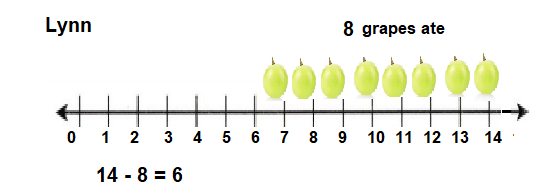
Question 3.
The Lions scored 11 runs in a baseball game. The Tigers scored 7 runs. Did the Tigers score 3 fewer runs than the Lions? Explain.
Answer: yes
Explanation:
Number of runs scored by Lions = 11
Number of runs scored by Tigers = 7
By using equation 7 + 3 = 11
And 11 – 7 = 3
Question 4.
Complete the explanation below for how to find 8 + 9. Use pictures, words, or numbers to complete the explanation.
I know that 8 + 8 = 16.
Answer: 17
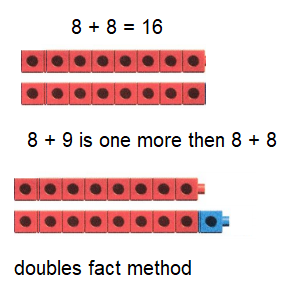
Problem Solving
Performance Task Puppies Sold The Sunset Pet Store sells puppies. The table shows how many puppies were sold Monday through Thursday.

Is the total number of puppies sold on Tuesday and Wednesday less than the number of puppies sold on Monday?
Answer : NO
Explanation:
Number of puppies sold Tuesday and Wednesday = 10 + 7 = 17
Number of puppies sold on Monday = 16
So the difference = 17 – 16 = 1
Question 5.
Make Sense Will you use all the numbers in the table to solve the problem? Explain.
Answer: NO
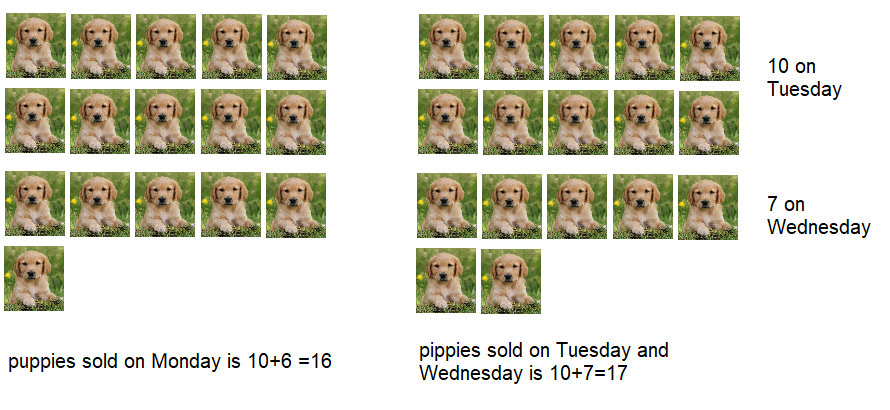
Explanation:
Puppies sold on Monday is 16
puppies sold on Tuesday and Wednesday 10+7=17
17 is 1 more then 16, So Puppies the total number of puppies sold on Tuesday and Wednesday not less than the number of puppies sold on Monday.
Question 6.
Model Write an equation to find the total number of puppies sold on Tuesday and Wednesday. Solve.
Answer:
10 + 7 = 17
Question 7.
Explain Solve the problem. Use words, pictures, and . numbers to explain your work and thinking.
Answer:
First count the puppies sold on Monday it is 16
then count the puppies sold on Tuesday and then add it to the puppies sold to Wednesday( 10 + 7 = 17)
comparing the puppies sold on Monday to the Tuesday and Wednesday
the answer is
the total number of puppies sold on Tuesday and Wednesday is one mote than the number of puppies sold on Monday.
Topic 1 Fluency Practice Activity
Find a Match
Find a partner. Point to a clue. Read the clue.
Look below the clues to find a match. Write the clue letter in the box next to the match.
Find a match for every clue.
I can … add and subtract within 20.
Clues
A. Near doubles with sums near 8
B. Every difference is 6.
C. Ways to make 12
D. Exactly two differences equal 9.
E. Every sum is greater than 14.
F. Exactly three differences are equal.
G. Near doubles with sums near 6
H. Every difference equals 14 – 7.

Read the clues carefully, you will get all answers
Answer:
Explanation:
A. Near doubles with sums near 8
Explanation:
3+4 = 7 or 4+3 = 7
3+4 is one more then 3+3 and the sum is near to 8
4+5 = 9 or 5+4 = 9
4+5 is one more then 4+4 and the sum is near to 8
So the clue is matched
B. Every difference is 6.
Explanation:
11-5 =6, 10-4 =6, 12-6 =6 and 9-3 =6
the difference is 6
So, the clue is Matched.
C. Ways to make 12
Explanation:
5+7=12, 6+6=12, 8+4=12 and 9+3=12
So, the clue is matched.
D. Exactly two differences equal 9.
Explanation:
9-0=9 and 16-7=9
So, the clue is matched.
E. Every sum is greater than 14.
Explanation:
8+9=17, 7+8=15, 8+7=15 and 6+9=15
So, the clue is matched
F. Exactly three differences are equal.
Explanation:
10-5=5, 12-7=5 and 13-8=5
So, the clue is matched.
G. Near doubles with sums near 6
Explanation:
4+3=7 or 3+4=7, 3+2=5 or 2+3=5
So, the clue is matched.
H. Every difference equals 14 – 7.
Explanation:
9-2=7, 13-6=7, 8-1=7 and 15-8=7
So, the clue is matched.
Topic 1 Vocabulary Review
Understand Vocabulary
Word List
- addend
- bar diagram
- difference
- doubles
- equation
- near doubles
- sum
Question 1.
Circle a doubles fact.
7 + 7 = 14
6 + 7 = 13
7 + 0 = 7
Answer:
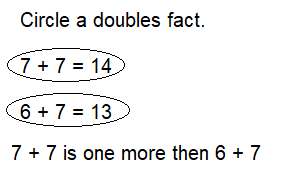
Question 2.
Circle a near doubles fact.
4 + 4 = 8
4 + 1 = 5
4 + 5 = 9
Answer:
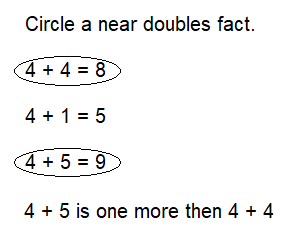
Question 3.
Write a subtraction equation using numbers and symbols.
Answer:
9 – 4 = 5
7 – 4 = 3
Explanation:
By subtracting smaller number from bigger number we get the difference.
Question 4.
Find the sum of 8 + 6.
Answer: 14
8 + 6 = 14
Explanation:
By adding 6 to 8bwe get 14.
Question 5.
Find the difference of 12 – 5.
Answer: 7
12 – 5 = 7
Explanation:
By substracting smaller number 5 from bigger number 12 we get the difference 7.
Use Vocabulary in Writing
Question 6.
Describe how you can make a 10 to add 7 + 4. Use a term from the Word List.
Answer:
7 + 4 =11
Explanation:
7 and 4 are addends
11 is the sum
7 + 3 = 10
10 + 1 =11
Topic 1 Reteaching
Set A
You can count on to find a sum.

Count on to find the sum. Then change the order of the addends.
Question 1.
9 + 3 = ______
______ + ______ = ______
9 + 3 = ______ + ______
Answer:12
9 + 3 = 12
3 + 9 = 12
9 + 3 = 3 + 9
Explanation:
In additions if we change the addends from left to right or right to left the sum will be the same.
Question 2.
6 + 4 = ______
______ + ______ = ______
6 + 4 = ______ + ______
Answer: 10
6 + 4 = 10
4 + 6 = 10
6 + 4 = 4 + 6
Explanation:
In additions if we change the addends from left to right or right to left the sum will be the same.
Set B
You can use doubles to help you add a near double.

Complete the doubles facts. Use the doubles facts to solve the near doubles.
Question 3.
8 + 8 = ______
So, 7 + 8 = ______
Answer:
8 + 8 = 16
So, 7 + 8 =15
7 + 8 is one less then 8 + 8
Explanation:
According to double fact

Question 4.
5 + 5 = ______
So, 6 + 5 = ______
Answer:
5 + 5 = 10
6 + 5 = 11
6+5 is one more then 5+5
Explanation:

Set C
You can make a 10 to help you add 8 + 6.

Make a 10 to add.
Question 5.
8 + 4 = ?

Answer: 12
Explanation:

Set D
You can count on or count back to find 11 – 4.

Count on or count back to subtract. Show your work on the number line.
Question 6.
8 – 5 = ☐

Answer: 3

Explanation:
Start at 8 and count back 5 moves to get 3.
Question 7.
15 – 6 = ☐

Answer:9

Explanation:
Start at 15 and count back 6 moves to get 9.
Set E
You can think addition to help you subtract.
Find: 16 – 9 = ?
Think: 9 + 7
So, 16 – 9 = 7
Subtract. Write the addition fact that helped you.
Question 8.
13 – 7 = ______
7 + ______ = 13
Answer: 6
Explanation:
Double fact
13 – 7 = 6
7 + 6 = 13
6 + 7 = 13
Question 9.
17 – 9 = ______
9 + ______ = 17
Answer: 8
Explanation:
Double fact
17 – 9 = 8
9 + 8 = 17
8 + 9 = 17
Set F
You can make a 10 to subtract. Find 17 – 8.

Make a 10 to find 13 – 8. Draw counters to show your work.
Question 10.

13 – ______ = 10
10 – ______ = ______
13 – 8 = ______
Answer:
13 – 3 = 10
10 – 5 = 5
13 – 8 = 5
Explanation:

Set G
You can use addition or subtraction to solve word problems.
11 grapes are in a bowl. 9 grapes are in a cup. How many fewer grapes are in the cup?
11 – 9 = 2,
9 + 2 = 11
So, 2 fewer grapes are in the cup.
Write an equation to solve each problem.
Question 11.
13 shirts are in a closet. 8 shirts are in a box. How many more shirts are in the closet?
![]()
___5_____ more shirts
Answer:
5 shirts are there in the closet.
Explanation:

Question 12.
Drake has 10 more books than Yuri. Yuri has 10 books. How many books does Drake have?
![]()
________ books
Answer:
Drake have 20 books.
Explanation:

Set H
Thinking Habits
Construct Arguments
How can I use math to explain why my work is correct?
Did I use the correct numbers and symbols?

Solve. Use words, pictures, or numbers to construct arguments.
Question 13.
Tyler read 15 pages of a book. Ann read 9 pages of the same book. Did Tyler read 4 more pages than Ann? Explain.
Answer: No
Tyler read 6 more pages then Ann
Explanation:
15 – 9 = 6
Tyler read 15 pages
Ann read 9 pages
The difference is 6 pages
Topic 1 Assessment Practice
Question 1.
Tom draws 7 bugs. Gina draws 4 bugs. How many bugs did they draw in all?
Which shows how to count on to solve the problem?
A. 7…8, 9, 10, 11
B. 4…5, 6, 7
C. 7 + 4
D. 4 + 7
Answer: A
Explanation:
Keep 7 in mind 4 on fingers
after 7…count 8,9,10,11
Total 7+4=11 bugs
Question 2.
Lilly has 7 fish. Jack has 1 more fish than Lilly.
Which equations show how many fish in all? Choose all that apply.
☐ 7 + 7 + 7 = 21
☐ 7 + 1 = 8
☐ 7 + 7 + 1 = 15
☐ 7 + 7 = 14
☐ 7 + 8 = 15
Answer: 15
Explanation:
Double fact method
7+8 is one more then 7+7
7 + 8 = 15
Question 3.
Use the ten-frames. Show how to find the sum of 8 + 7 by making a 10. Then fill in the gray boxes.

Answer: 15
Explanation:

Question 4.
Which have a sum of 18? Choose all that apply.
☐ 10 + 8
☐ 8 + 10
☐ 9 + 8
☐ 8 + 8
☐ 9 + 9
Answer:
10 + 8 = 18
8 + 10 = 18
9 + 9 = 18
Question 5.
7 friends go to the movies. They have 4 tickets. How many more tickets do they need?
Draw lines to match each solution to how it was solved.

Answer:

Question 6.
Nita has 14 grapes. She eats 6 grapes.
Which addition fact can help you find how many grapes Nita has left?
A. 6 + 6 = 12
B. 6 + 7 = 13
C. 6 + 8 = 14
D. 8 + 8 = 16
Answer:
Option C
Explanation:
6 + 8 = 14
By adding 8 to 6 we get the sum 14.
Question 7.
Use the ten-frames. Show how to make a 10 to find 13 – 7. Then complete the equation.

13 – 7 = ______
Answer: 6
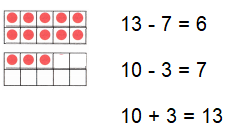
Question 8.
Bruce has some coins. He gives 4 coins to his brother. Now Bruce has 9 coins. How many coins did Bruce have at first? Write an equation to solve.
![]()
_________ coins
Answer:
Bruce have at first 13 coins.
Equation,
![]()
Question 9.
Maria has 4 pears. She buys some more pears. Now she has 12 pears. How many pears does Maria buy?
Part A
Draw a picture to model the problem.
Answer:
Maria brought 8 pears

Part B
Write an equation to solve the problem.
![]()
_________ pears
Answer:
8 pears
![]()
Question 10.
The team has 9 players. Then 2 players quit. After that, 5 players join the team. How many players does the team have now?
Use the numbers on the cards. Complete both equations to solve the problem.

Answer:
12 players

Question 11.
Choose Yes or No to show if 7 will make each equation true.

Answer:

Question 12.
Matt finds 9 sticks at the park. Mabel finds 7 sticks. How many sticks do they find in all? Write an equation to explain.
![]()
_________ sticks in all
Answer:
16 sticks
![]()
Question 13.
Choose Yes or No to show if 8 will make each equation true.

Answer: 8

Question 14.
Josh ate 6 fewer cherries than Gail. Gail ate 15 cherries. How many cherries did Josh eat?
Answer:
Josh ate 9 cherries
Explanation:
Number of cherries Gail ate = 15
Josh ate 6 fewer cherries than Gail.
Total number of cherries Josh ate = 15 – 6 = 9
Part A
Draw a picture to model the problem.
Answer:
Part B
Write an equation to solve the problem.
![]()
________ cherries
Answer:
9 cherries
Equation:
![]() cherries
cherries
Question 15.
The table shows how many pictures 3 friends made.

Choose one of the friends. Write the name of the friend you choose.
How many pictures did that friend make?
Write an equation to solve the problem.
![]()
_________ pictures
Answer:
Brian, 13 pictures
Equation:

Topic 1 Performance Task
Farm Kittens
Many kittens are born each summer at the Sunshine Farm. The table shows the number of kittens born at the farm from June to August.

Question 1.
During which two months were a total of 20 kittens born?
Answer:
June + August
Explanation:

During the month of June and July
Answer: 21
Explanation:

Question 2.
Write an equation to find the total number of kittens born in July and August. Solve.
Answer: 15
Equation:

Question 3.
Joy said 5 more kittens were born in June than in August. Do you agree? Circle Yes or No. Show your work to explain.
Yes
No
Answer:
6 more kittens were born
![]()
Question 4.
Use the clues to complete the table below.
- No kittens were born in December, January, and February.
- In March, 6 kittens were born.
- Three kittens were born in April and in September.
- In May, 4 kittens were born.
- Two kittens were born in October and in November

Answer:

Question 5.
Joy says that more kittens were born in the summer than in all other seasons combined. Is she correct? Explain.
Answer:
Yes, its correct
Explanation:
First add 13 + 4 = 17 (Kittens were born in the spring and Fall seasons)
Now subtract the above sum from the kittens born in summer
28 – 17 = 11
Question 6.
How many more kittens were born in the spring than in the fall? Show how to solve the problem with a subtraction equation.
Answer:
9 kittens
Equation:
13 – 4 = 9
